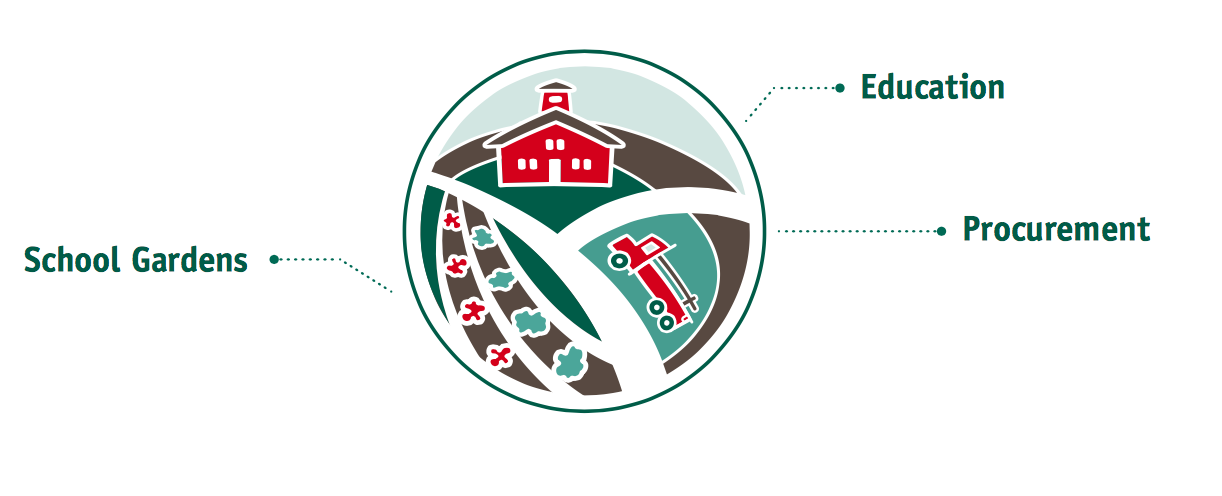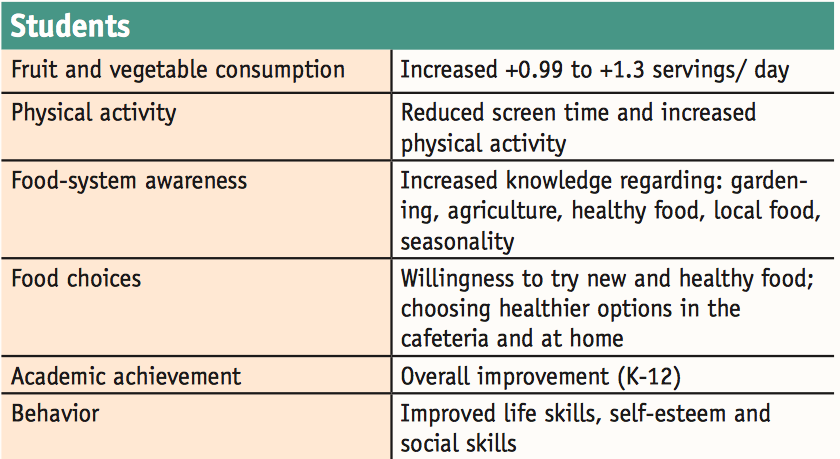Overview
Farm to School is a far-reaching non-profit with a presence in more than 44% of United States schools (40,000 total schools participating). Farm to School’s website boasts many statistics lauding the program, but finding third-party evaluations of the organization is more difficult. Overall, the program does seem to have improved school lunches in America and should have more support from the government. Despite its successes, the organization still comes up short in that it would need five times more funding to fulfill demand. In response to this need, in October 2015 the Farm to School Act upped the program’s governmental funding from $5 million annually to $15 million.

Education, School Gardens, and Procurement

A Farm to School program must include three of the following components: Education, School Gardens, or Procurement. Education pertains to developing and implementing a nutrition education program. School gardens provide kids with hands-on experience with farming, and procurement is the procurement of local, nutritious produce and food. Procurement is really where student nutrition is directly impacted, as it means that schools are actually putting healthier food on the table. However, Education and School Gardens provide two other important aspects to nutrition and health: knowledge and tangible experience.
Although any three of these categories are important and incorporating just one into a school’s curriculum can make a positive impact, it raises the question as to how many of the 40,000 US Schools with a Farm to School program are comprehensive programs that touch in all three areas—as having just one of the three programs can constitute as a Farm to School program. The success of a Farm to School program also depends on what makes a successful program:
One of the key lessons that has emerged from the evolution of farm to school programs is that to make these programs successful, support is needed from multiple sectors within the school community (parents, teachers, administrators) and outside it, including distributors, economic developers, health advocates and practitioners, policymakers, farmers and farm agencies, banks, media, community arts and others. Partnerships are the cornerstone of successful farm to school implementation.
Thus, Farm to School programs need support from many sectors to succeed. Only requiring one of the three components help schools with limited resources get started, but to be as comprehensive as possible, the program should include education, school gardens, and procurement.

Kids Win, Farmers Win, Communities Win: Benefits
One of Farm to School’s tailgates is “Kids win, farmers win, communities win.” But is there empirical evidence pointing to the benefits of Farm to School? Does Farm to School’s slogan ring true in reality? A report issued by Farm to School summarized various findings regarding the benefit of Farm to School programs. These statistics can be found in the charts below.
All of these statistics (left) show that Farm to School has a very positive impact on various levels of the community. However, it must be noted that these facts are generally taken from small-scale studies of particular programs. Often several small-scale studies corroborate in their findings, pointing to the idea that these statistics could be accurate across the spectrum of Farm to School programs. However, ultimately the data is reflecting only programs that have been studied.
positive impact on various levels of the community. However, it must be noted that these facts are generally taken from small-scale studies of particular programs. Often several small-scale studies corroborate in their findings, pointing to the idea that these statistics could be accurate across the spectrum of Farm to School programs. However, ultimately the data is reflecting only programs that have been studied.
A more wide reaching survey of 42000 schools that have farm to school:
- Reduced plate waste (17 percent);
- Improved acceptance of the healthier school meals (28 percent);
- Increased participation in school meals programs (17 percent);
- Lower school meal program costs (21 percent); and
- Increased support from parents and community members for the healthier school meals (39 percent).
A report written by Anupama Joshi shows that of out of 11 studies explored, 10 found that Farm to School programs have positive impacts on student dietary behaviors. One reported no significant change in eating habits.
Additionally, some Farm to School programs can have an impact outside of school. Five of the eleven studies evaluated in the report found that students ate healthier outside of school as a result of a Farm to School program.
Overall, Farm to School does seem to have a positive and substantial impact on student eating habits in the United States. The reality remains, however, that these programs such as Farm to School need to be expanded on and advanced. Nutrition education must be part of both public and private school curriculums, students need to be gaining some kind of tangible experience with agriculture, and cafeterias should provide healthy, sustainable, and appealing food to students of all backgrounds.
How Does Farm to School Operate?
Various factors go into determining how Farm to School programs operate. Funding is an important component to the functioning of Farm to School. The Healthy, Hunger-Free Kids Act of 2010 allotted $5 million per year to be given to Farm to School initiatives through a federal grant program. Then, in October 2015, the Farm to School Act raised this number to $15 million. Other sources of funding support Farm to School programs exist, including state grants, foundational grants, business sponsorships, and fundraising events.
Though money is certainly important in the success of Farm to School programs, state policies make a difference. Legislative support for Farm to Schools differs greatly from state to state. There is a major trend in both the increase in farm to school programs and in legislative acts passed. In the State Farm to School Legislative Survey it is written:
Simply put, strong laws facilitate strong programs.
Legislation falls under several categories, including:
- establishing councils and paid positions for farm to school coordinators and groups
- policies that encourage and/or help fund local procurement
- support for school gardens/farms
- general support for farm to school programs
Farm to School programs need both fiscal and social support to function optimally and to expand. Thus, it is important that states continue to enact legislation supporting Farm to School.
Intersectionality
Policies aiming to improve nutrition for kids must approach the issue from an intersectional lens. Although Farm to School should publish more data on which groups are benefiting most from farm to school, and should better specify its policies in retaining cultural autonomy regarding food, there is evidence that the organization’s goal is to bring nutritious food to all children. In the recent Evaluation Transformation, the idea that Farm to School programs must be implemented in ways specific to each school is underlined. However, it would be beneficial to put this in the context of intersectionality, and to explore which schools need improved foods the most.
One exciting aspect of Farm to School is the program’s role in Native American communities. In the Farm to School Act of 2015, one of the four major points highlighted was “enhancing access among tribal schools to farm-fresh and traditional foods, especially from tribal producers.” Farm to School seems to understand the importance of tradition and culture in addition to nutrition for Native communities. A Farm to School program in the Navajo Nation has so far proved successful and strives to provide students with culturally relevant, nutritious, and local foods. Other programs in Native American communities have shown promising futures. However, ultimately nutrition remains a major problem for these communities and regulations present extra hurdles that can cause progress to occur more slowly.
Below is an interesting video about a successful Farm to School program in Tucson:
Shifting Mindsets
Farm to school helps in the larger need to shift the United States attitude towards food. As Farm to School points out that once individual programs become established, they can benefit society in a much larger way. Social justice issues are more likely to be discussed. In Farm to School’s recent publication “Evaluation for Transformation” it is written:
For example, farm to school programs lift up foodservice labor by providing opportunities for professional development, empowerment through foodservice employment and recognize our “lunch ladies” as the professional chefs that they are.
Clearly, Farm to School is a program that can begin the larger discussion that is needed to repair the mostly broken culture regarding food in the United States.
Summary and the Future
Farm to School presents a promising case in which kids’ nutrition, farmers, and communities benefit in a variety of ways. Increased funding and supportive legislative policies that are expanding the impact of Farm to School—for example, making it possible to provide more programming when school is not in session. But the organization could grow more and improve to be more inclusive and comprehensive. The programs need more support, both fiscal and human. Additionally, although Farm to School emphasizes the importance of how programs can not be achieved through a one-size-fits-all model, intersectionality and diversity should be addressed in a far more direct manner.
Overall, Farm to School programs have tremendous momentum and are growing in scope. More children will be experiencing the impact of Farm to School programs in the years to come.
Resources and Further Reading
Issued by Farm to School and USDA:
Evaluation for Transformation: A Cross-Sectoral Evaluation Framework for Farm to School


